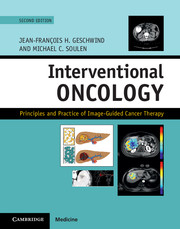Book contents
- Frontmatter
- Contents
- List of contributors
- Section I Principles of oncology
- Section II Principles of image-guided therapies
- Section III Organ-specific cancers – primary liver cancers
- Section IV Organ-specific cancers – liver metastases
- 16 Colorectal masses: Ablation
- 17 Assessment, triage, and chemoembolization for colorectal liver metastases
- 18 Radioembolization for colorectal liver metastases
- 19 Assessment, triage, and liver-directed therapies for neuroendocrine tumor metastases
- 20 Preoperative portal vein embolization
- Section V Organ-specific cancers – extrahepatic biliary cancer
- Section VI Organ-specific cancers – renal cell carcinoma
- Section VII Organ-specific cancers – chest
- Section VIII Organ-specific cancers – musculoskeletal
- Section IX Organ-specific cancers – prostate
- Section X Specialized interventional techniques in cancer care
- Index
- References
18 - Radioembolization for colorectal liver metastases
from Section IV - Organ-specific cancers – liver metastases
Published online by Cambridge University Press: 05 September 2016
- Frontmatter
- Contents
- List of contributors
- Section I Principles of oncology
- Section II Principles of image-guided therapies
- Section III Organ-specific cancers – primary liver cancers
- Section IV Organ-specific cancers – liver metastases
- 16 Colorectal masses: Ablation
- 17 Assessment, triage, and chemoembolization for colorectal liver metastases
- 18 Radioembolization for colorectal liver metastases
- 19 Assessment, triage, and liver-directed therapies for neuroendocrine tumor metastases
- 20 Preoperative portal vein embolization
- Section V Organ-specific cancers – extrahepatic biliary cancer
- Section VI Organ-specific cancers – renal cell carcinoma
- Section VII Organ-specific cancers – chest
- Section VIII Organ-specific cancers – musculoskeletal
- Section IX Organ-specific cancers – prostate
- Section X Specialized interventional techniques in cancer care
- Index
- References
Summary
Radioembolization is internal brachytherapy that delivers high doses of beta radiation locally into liver tumors. Glass or resin microspheres incorporating the radioactive isotope yttrium-90 (90Y) are directly injected into the hepatic arteries feeding the tumor. Resin microspheres differ from glass microspheres in that they have lower specific gravity, lower activity, and a higher number of particles. As part of the selection process for radioembolization, clinical history, laboratory values and performance status are obtained and patients are initially evaluated and staged using cross-sectional imaging techniques. Pretreatment imaging workup is required to visualize the entire liver vasculature and flow patterns, including the detection and selective occlusion of vessels which might allow 90Y microspheres to enter extrahepatic tissues. During the treatment procedure, microspheres are injected through a temporary angiographic catheter placed percutaneously via the femoral or brachial artery. Clinical toxicity is assessed at the time of treatment and approximately 2–3 months thereafter. A comprehensive review of the technical and methodological considerations in 90Y has been previously published.
Two radioembolic products are commercially available. Thera-Sphere (glass microspheres) gained a Humanitarian Device Exemption from the Food and Drug Administration (FDA) in 1999 for the treatment of unresectable hepatocellular carcinoma (HCC) in patients with or without portal vein thrombosis (PVT) who can have appropriately positioned hepatic arterial catheters. SIR-Spheres (resin microspheres) gained full premarketing approval from the FDA in 2002 for the treatment of unresectable colorectal liver metastases in conjunction with intrahepatic floxuridine (FUDR).
Both devices have approval for treatment of liver cancer in Europe and various Asian countries.
Introduction
Despite advances in systemic chemotherapy and monoclonal antibodies, the liver usually remains the site of tumor resistance and ultimately the patient's death. Approximately 60% of patients diagnosed with colorectal carcinoma eventually develop hepatic metastases, with the liver as the dominant site of disease. Complete surgical resection remains the best option for a cure. However, surgical resection is currently only possible in less than 20% of patients with metastatic colorectal cancer. Further, about 60–90% of patients treated with neoadjuvant chemotherapy and liver resection will experience a recurrence of their liver tumors. In patients with unresectable liver metastases, with or without extrahepatic disease, systemic chemotherapy is still the standard of care for first- and second-line treatment.
- Type
- Chapter
- Information
- Interventional OncologyPrinciples and Practice of Image-Guided Cancer Therapy, pp. 158 - 164Publisher: Cambridge University PressPrint publication year: 2016



